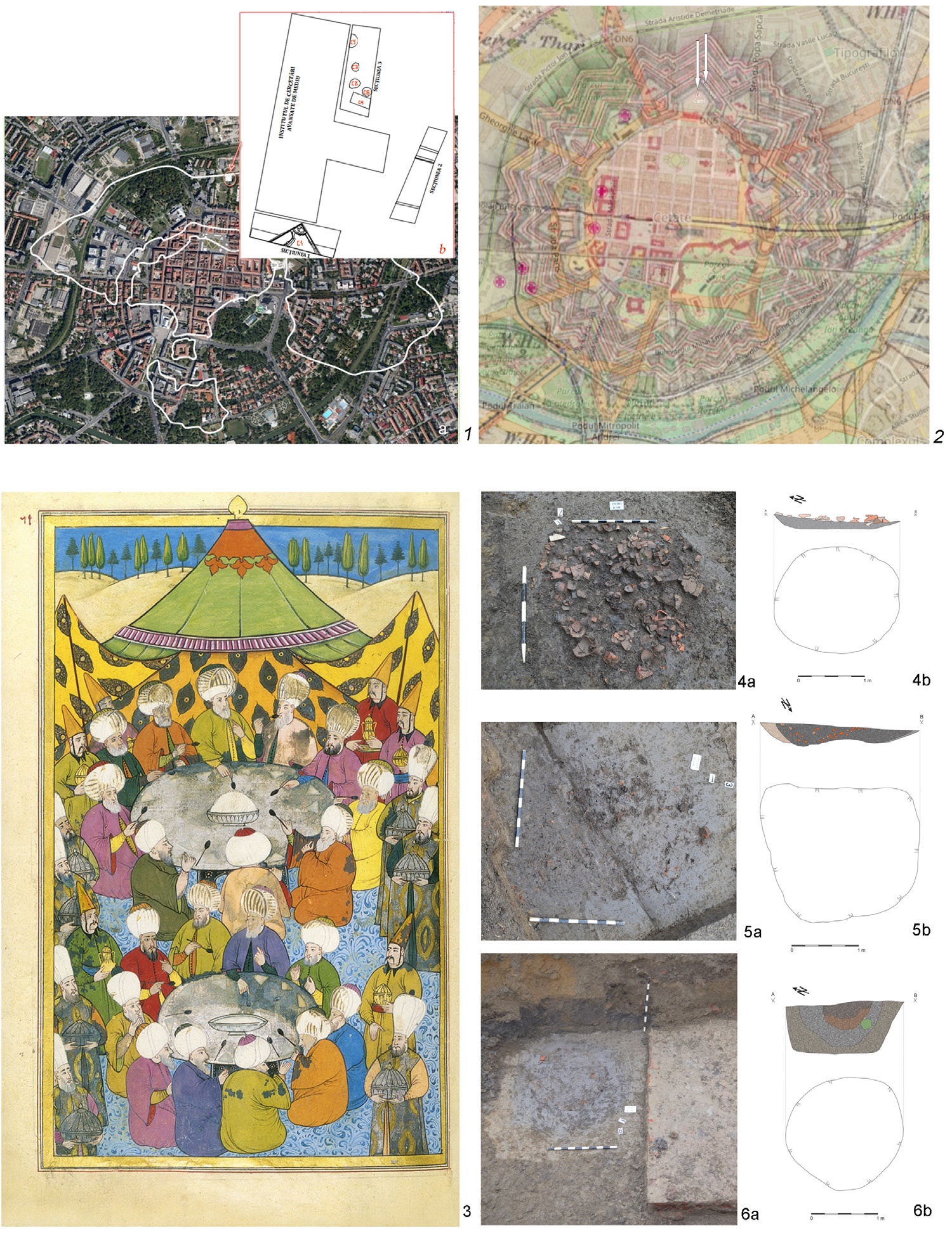Login to access subscriber-only resources.
Figures: Sgraffito pottery in the Ottoman Timișoara “Palanca Mare” suburb—ICAM excavation point (2015 Campaign)
 Figure 1. 1a) ICAM excavation mark (yellow square) on the map of Timişoara city and its location in relation to the appx. limits (white line) of Timişoara fortress in 1716 (Overlap: Google Earth; processed after Opris 2007, fig. 7); 1b) Detailed excavation plan; 2) Location of the bastion BIX Carol and the Countergard IX in the map of Timișoara city. Overlapping with The Second Military Survey of the Habsburg Empire (1806-1869) (processed after mapire.eu); 3) Ottoman miniature, year 1720 (after Yerasimos 2007, 41.jpg); 4a, b) Feature C2, contour and drawings with details (photo, drawing by A. Gașpar); 5a, b) Feature C3, contour and drawings with details (photo, drawing by A. Gașpar); 6a, b) Feature C6, contour and drawings with details (photo, drawing by A. Gașpar).
Figure 1. 1a) ICAM excavation mark (yellow square) on the map of Timişoara city and its location in relation to the appx. limits (white line) of Timişoara fortress in 1716 (Overlap: Google Earth; processed after Opris 2007, fig. 7); 1b) Detailed excavation plan; 2) Location of the bastion BIX Carol and the Countergard IX in the map of Timișoara city. Overlapping with The Second Military Survey of the Habsburg Empire (1806-1869) (processed after mapire.eu); 3) Ottoman miniature, year 1720 (after Yerasimos 2007, 41.jpg); 4a, b) Feature C2, contour and drawings with details (photo, drawing by A. Gașpar); 5a, b) Feature C3, contour and drawings with details (photo, drawing by A. Gașpar); 6a, b) Feature C6, contour and drawings with details (photo, drawing by A. Gașpar).

Figure 2. 1a–c) Kaolin fragment with combed decoration and glaze (photo, drawing by A. Gașpar); 2a–c)
Sgraffito bowl, part of the wall (photo, drawing by A. Gașpar); 3) Stack of glazed bowls separated by tripod stilts. Graphic model (made by A. Gașpar); 4a-c) Sgraffito bowl (photo, drawing
by A. Gașpar); 5a-c) Sgraffito bowl (photo, drawing by A. Gașpar).
Figure 2 pottery descriptions
1a–c. Combed sherd. White kaolin paste. Wall with a constant thickness. Decorated on one side, vertically grouped into three tape registers: wavy lines at the center—five lines; right down—five
lines; right up—four lines. Motif covered with green glaze. Surface S3, feature C3.
2a–c. Bowl. Part of the vessel wall described above. Medium-fine clay, limestone, oxidizing firing,
complete, brown-brick color, overfiring traces. Wall thickness almost constant. Interior with
sgraffito decoration: two vertical registers, separation curve. In the first register: curved lines;
the vertically covered surface with bright glaze, left with brown, right with yellow, brown lines
and dots. Second register: green glaze. On the outside: white line of slip at the top, gray on the
non-slipped surface. (0–2.40) m, surface S3, feature C2.
3. Graphic reconstruction with a stack of glazed bowls separated by tripod stilts, with the sgraffito bowl as an example.
4a–c. Sgraffito bowl. Medium-fine clay with small pieces of limestone, oxidizing firing, complete,
brown-brick color, overfired traces. Hemispherical body, deep, wall thickness almost constant,
oblique cut and slightly rounded rim, two thin grooves on the outside. Inside with sgraffito
decoration, lines, semicircles, polychrome glaze. On the outside, white slip in the upper half
and yellowish green glaze, white line in the lower part, gray shade in the non-slipped part.
(2.50–2.60) m, surface S3, feature C2.
5a–c. Sgraffito bowl. Medium-fine clay with micaceous sparkles and small pieces of limestone, oxidizing firing, complete, brown-pink color. Deep and hemispherical body, 22 cm wide at the rim,
8 cm diameter of the ring foot with widened base and pulled inward, center button at the top.
Thick walls to the bottom, thick rim, sharply everted and slightly rounded out. Inner covered
with white slip, sgraffito decorated with rows of circles and leaves arranged radially, green
glaze, scars tripod stilt. On the outside, thin slip covers the upper half, spots, and drained green
glaze. Pink traces from overfired, on the non-slipped surface. Surface S3, feature C3, C6.
Adriana Gaşpar“Vasile Pârvan” Institute of Archaeology
© Equinox Publishing Ltd.

